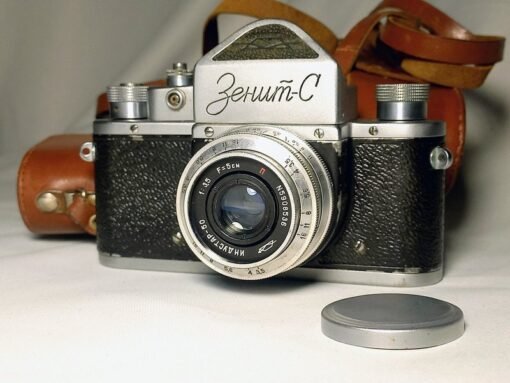Photography
Unveiling the Zenit-C: A Timeless Marvel of Soviet Camera Engineering
Welcome to the world of luxury and opulence, where craftsmanship meets innovation. Today, we delve into the captivating story of the Zenit-C, a Soviet single-lens reflex camera that revolutionized the photography industry. Prepare to be immersed in a world of elegance and sophistication as we explore the remarkable features and history of this iconic piece of art.

The Zenit-C emerged from the esteemed Krasnogorsk Mechanical Plant (KMZ) between 1955 and 1961, captivating photographers with its cutting-edge technology and impeccable design. It holds the distinction of being the first Soviet SLR camera to be manufactured on a large scale, with an impressive production of 232,949 units.
Picture this: it’s 1955, and photography enthusiasts across the Soviet Union are yearning for a camera that encapsulates both functionality and style. Enter the Zenit-C, the second model to grace the Zenit brand. Building upon its predecessor, the 1952 Zenit model, this camera brought forth two significant enhancements that set it apart.
The first notable improvement was the inclusion of a synchronization contact with a synchronization delay regulator, inspired by the rangefinder camera Zorki-C. This advancement necessitated modifications to the shutter release and film rewind buttons. Although lacking a built-in flash shoe, the Zenit-C provided a detachable bracket to attach the flash, ensuring seamless synchronization via a cable connection.

The second remarkable upgrade involved the mechanism responsible for lowering the mirror. Unlike its predecessor’s lever system, the Zenit-C adopted a miniature winch with a cord, resulting in a smoother and more reliable operation. These enhancements stood as a testament to the meticulous attention to detail and relentless pursuit of perfection exhibited by the KMZ engineers.
Indulge your senses as we explore the exquisite design of the Zenit-C. Crafted with precision, this camera boasted a robust cast aluminum alloy body, exuding an air of grandeur and durability. Its removable bottom cover added a touch of convenience, allowing for effortless film loading and maintenance.
Prepare to be captivated by the Zenit-C’s reflex viewfinder, complete with a matte glass focusing screen and a non-removable pentaprism. The camera embraced a horizontal cloth focal plane shutter, meticulously engineered to guarantee flawless mechanical operation. Compatible with 35mm perforated film (type 135) in cassettes, the Zenit-C captured the world in stunning 24x36mm frames.
Accompanying this pinnacle of luxury was the renowned Industar-22 3.5/50mm lens, a perfect companion for any discerning photographer. In later years, the Zenit-C graced the market with the Industar-50 lens, further enriching the shooting experience. This non-automatic camera featured a non-returning mirror, remaining in the viewing position solely when the shutter was cocked.
The Zenit-C holds an esteemed place in the annals of Soviet camera manufacturing. Its mass production marked a pivotal moment in the industry’s evolution, captivating both amateurs and professionals alike. By championing the Zenit brand’s popularity, it became a symbol of elegance and artistic expression.
Now, let’s address some of the most frequently asked questions about the Zenit-C:
- What makes the Zenit-C different from other SLR cameras of its time?
The Zenit-C stood out with its synchronization contact, synchronization delay regulator, and innovative mirror-lowering mechanism. - Can I attach a flash directly to the Zenit-C?
No, the Zenit-C did not have a built-in flash shoe. However, it came with a detachable bracket to attach the flash and connect it to the synchronization contact via a cable. - What type of film does the Zenit-C use?
The Zenit-C is compatible with 35mm perforated film (type 135) in cassettes, allowing for breathtaking captures. - Which lens typically accompanied the Zenit-C?
The Zenit-C was usually sold with the Industar-22 3.5/50mm lens, providing exceptional image quality. In later years, it was paired with the Industar-50 lens. - Is the Zenit-C an automatic camera?
No, the Zenit-C is a non-automatic camera with a non-returning mirror. The mirror remains in the viewing position only when the shutter is cocked. - How many Zenit-C cameras were manufactured?
A total of 232,949 Zenit-C units were produced, making it the first mass-produced Soviet SLR camera. - What impact did the Zenit-C have on Soviet camera manufacturing?
The Zenit-C played a crucial role in the development of Soviet camera manufacturing, paving the way for future innovations and establishing the Zenit brand’s prominence. - What are the dimensions of the frames captured by the Zenit-C?
The Zenit-C captures images in a frame size of 24x36mm, allowing for stunning compositions and artistic expression. - Can I still find a working Zenit-C camera today?
Yes, it is possible to find a working Zenit-C camera in the vintage market or through collectors. However, due to its age, availability may be limited, and it is essential to ensure the camera’s condition before making a purchase. - Is the Zenit-C suitable for professional photography?
While the Zenit-C was widely used by both amateur and professional photographers during its time, it may not meet the advanced requirements of modern professional photography. However, it can still be cherished as a piece of art and a testament to the golden era of Soviet camera manufacturing.
In conclusion, the Zenit-C stands as an enduring testament to the opulence and innovation that characterized the world of luxury photography. With its exceptional design, technological advancements, and timeless appeal, it continues to captivate photographers and enthusiasts worldwide. Embrace the allure of the Zenit-C and immerse yourself in a world where elegance meets functionality. Capture moments of abundance and prosperity with this remarkable piece of art.


